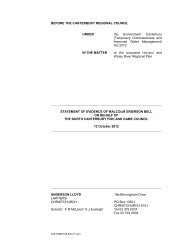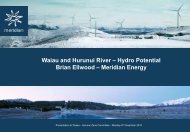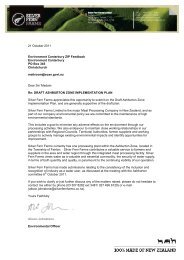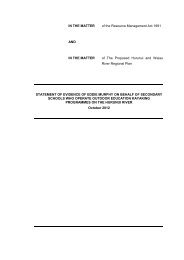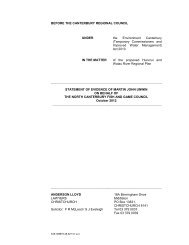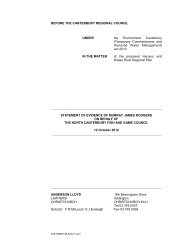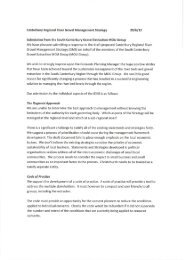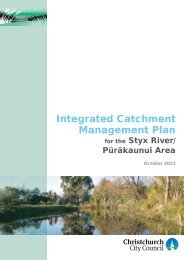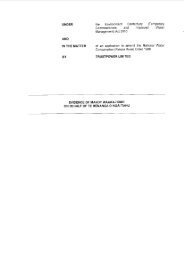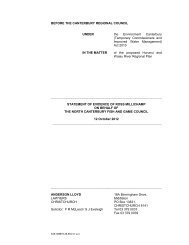20121.0 INTRODUCTIONGroundwater is an important resource in <strong>South</strong> <strong>Canterbury</strong> and the management of<strong>groundwater</strong> resources is aided by knowledge of the nature and distribution of geological<strong>for</strong>mations. The geological <strong>for</strong>mations of <strong>South</strong> <strong>Canterbury</strong> comprise a distinctive set oflayers (strata) which may conveniently be grouped within three categories, from oldest toyoungest; basement rock, Cretaceous-Cenozoic rocks and Quaternary sediments. Basementrock <strong>for</strong>ms the undermass of the region, and is dominated by hard sandstone (greywacke)and mudstone (argillite), in places metamorphosed to semischist. Covering the basementrock are Cretaceous-Cenozoic rocks, comprising a ‘layer-cake’ of deposits totalling morethan 1 km thick in eastern <strong>South</strong> <strong>Canterbury</strong>, including soft quartz sandstones andmudstones, a distinctive limestone band in the middle of the sequence, and greywackederivedmuds, sands and gravels towards the top of the sequence, which near Timaru andGeraldine are capped by a layer of basaltic volcanic rock. Quaternary sediments aredominated by river gravels and sands, and include the windblown loess that drapes much ofthe terraced and rolling lowland terrain. During the late Cenozoic, tectonic <strong>for</strong>ces have led tofolding, faulting and localised uplift in <strong>South</strong> <strong>Canterbury</strong>. In uplifted areas, erosion hasdissected or removed the cover rocks, exposing the basement rock. Only the <strong>Canterbury</strong>Plains have remained largely unaffected by uplift. A more detailed outline of the geologicalorigins of <strong>South</strong> <strong>Canterbury</strong> is provided by Barrell (2008) and references therein.<strong>Geological</strong> maps depict the distribution of geological layers at the ground surface, but do notprovide a direct picture of what lies deeper underground. A common way of definingsubsurface geological features is by means of structure <strong>contours</strong>, which are lines of equalelevation drawn on a two-dimensional (2D) geological feature, such as a boundary betweentwo geological layers. Structure <strong>contours</strong> are analogous to topographic <strong>contours</strong> on the landsurface, and usually are expressed in the same units, metres relative to sea level. Structure<strong>contours</strong> impart a third dimension to a 2D geological feature.The most important aquifers of <strong>South</strong> <strong>Canterbury</strong> are the Quaternary sediments, and also theKowai Formation, which is the name applied to greywacke-derived sands and gravels lyingnear the top of the Cretaceous-Cenozoic rock sequence. The top of the Kowai Formation,which includes gravel-dominated sediments widely known as ‘Cannington Gravel’,approximates the base of the Quaternary sediments beneath the <strong>Canterbury</strong> Plains.Elsewhere, Quaternary sediments rest uncon<strong>for</strong>mably on the Kowai or older <strong>for</strong>mations.The <strong>Canterbury</strong> Regional Council (Environment <strong>Canterbury</strong>) engaged the Institute of<strong>Geological</strong> and Nuclear Sciences Limited (GNS Science) to provide an interpretation, bymeans of structure <strong>contours</strong>, of the subsurface positions of the top and bottom of the KowaiFormation and the top of the basement rock across a wide tract of the eastern part of <strong>South</strong><strong>Canterbury</strong>, extending from near Geraldine to the Waitaki rivers and including theCannington/Fairlie basins inland as far as Burkes Pass (Fig. 1).The structure contour interpretation of the subsurface geometry of these geologicalboundaries is primarily intended as an input to a 3D <strong>groundwater</strong> model that thatEnvironment <strong>Canterbury</strong> proposes to build to assist <strong>groundwater</strong> management.GNS Science Consultancy Report 2012/245 1
20122.0 INFORMATION SOURCESThe in<strong>for</strong>mation used in this assessment was:• Published geological maps from the GNS Science 1:250,000 ‘QMAP’ (Quartermillion-scalemap) series, Waitaki sheet (Forsyth 2001) and Aoraki sheet (Cox &Barrell 2007), as well as the underlying digital GIS databases (Figs. 2a, 2b);• Unpublished QMAP geological ‘record’ maps, comprising field observations and otherdetailed published geological in<strong>for</strong>mation hand-drawn onto 1:50,000 scaletopographic maps, held on file at the GNS Science Dunedin office;• Measurements of thicknesses of rock strata from geological exposures (‘measuredsections’) at various places around the region (Field et al. 1989). Indicative locations(some measured section lines extend <strong>for</strong> several kilometres) are shown in Fig. 3;• Topographic in<strong>for</strong>mation, in particular topographic <strong>contours</strong>, from Land In<strong>for</strong>mationNew Zealand digital map images and datasets;• Interpretations and evaluations from recent <strong>groundwater</strong> geology assessments in thestudy area by Forsyth (2004) and Barrell (2008);• In<strong>for</strong>mation from available bore hole records, particularly the Environment <strong>Canterbury</strong>bore hole database (see Fig. 3 <strong>for</strong> examples);• In<strong>for</strong>mation from geophysical surveys in the Cannington basin (Langdale & Stern1998) and lower Waitaki valley (Woodward et al. (2003).3.0 GEOLOGICAL CONTOURINGStructure <strong>contours</strong> were drawn on the basis of the in<strong>for</strong>mation sources outlined in Section2.0. The <strong>contours</strong> are a geological interpretation, based on weights of evidence from thevarious datasets, and in only a few places are constrained by direct observations. Theyrepresent a hypothesis as to the geometries of the targeted subsurface geologicalboundaries. It is anticipated that the contour models should be refined and improved upon inthe future as additional in<strong>for</strong>mation comes to hand, such as by the drilling of new bores.3.1 MethodologyThe most important inputs to the contouring are surface geological data from maps andmeasured sections, with ground surface elevations obtained from topographic map <strong>contours</strong>.Subsurface in<strong>for</strong>mation from bore holes and geophysical surveys, while valuable, has somelimitations. The bore hole dataset has three significant limitations. First, only some of thebores have records (logs) of the geological materials (lithologies) encountered during drilling.Second, the detail and reliability of lithological logs is highly variable; in many cases even ageological specialist may have difficulty in identifying specific geological <strong>for</strong>mations from borehole lithological logs (see discussion in Forsyth 2004). Third, most bores are relativelyshallow, rarely more than 100 m deep, whereas the geological <strong>for</strong>mation boundaries that areGNS Science Consultancy Report 2012/245 2




